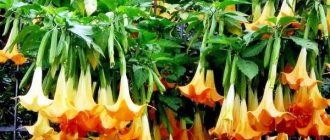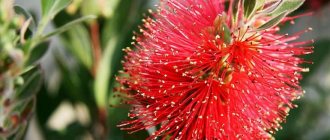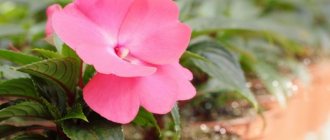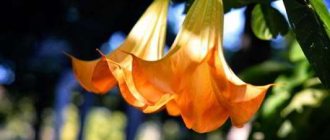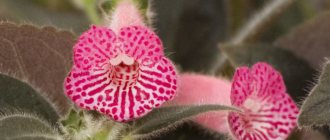In warmer regions, Brugmansia can be used as a garden crop. In most Russian regions it is cultivated as a pot or indoor plant. Brugmansia is native to the tropics and subtropics of South America. There are 7 wild species found there. All modern garden forms and hybrids were developed on their basis.
Be sure to pay attention to the beautiful Beloperone plant.
| Growth rate is average. |
| Basically, it blooms all summer, but if illuminated in the evening, it can bloom until winter. |
| Average difficulty of growing. |
| It is a perennial plant. |
Useful properties and toxicity of Brugmansia
At home, the local population uses Brugmansia as a medicinal plant. Its hallucinogenic properties are widely used for religious rituals. It should be borne in mind that all parts of the plant are highly poisonous. They contain high levels of scopolamine and atropine. The rich aroma of Brugmansia flowers can cause a severe headache.
Brugmansia in landscape design, combination with other plants
The bushes look great against the backdrop of carpet flower beds and flower lawns. The stunning view is formed against the backdrop of plain hedges. You can plant the trees in pre-prepared barrels, place the containers at the front entrance of the site or along the perimeter of the gazebo.
The shrub looks nice next to other representatives of flower crops. For example, you can plant hibiscus nearby. Dahlias and roses will also become worthy neighbors of Brugmansia.
Brugmansia: care at home. Briefly
Brugmansia at home requires certain care:
| Temperature | Room temperature in summer, no higher than +15° in winter. |
| Air humidity | Requires a high humidity level of at least 60%. |
| Lighting | Intensive, when placed on the south side with shading. |
| Watering | The substrate must be kept moist at all times. |
| Priming | Light, fertile, always with a drainage layer. |
| Feeding and fertilizer | Requires constant use of fertilizers. |
| Brugmansia transplant | As it grows, sometimes up to 2-3 times a year. |
| Reproduction | Seeds or apical cuttings. |
| Features of cultivation | Requires constant shaping and pruning. |
How to propagate the “intoxicating tree”
Most often, at home, gardeners use two methods of propagation - cuttings and seed. But please note: hybrid varieties cannot be propagated by seed. That is, it will work out, but not completely: the characteristics of the species will not be preserved with this method of reproduction.
Algorithm for propagation by cuttings
The off-season is the ideal period for cuttings. By and large, it makes absolutely no difference when the process is carried out - in spring or autumn. The main thing is to cut the shoots with a reserve, so that later you can select the strongest and most suitable ones.
- Slicing. We are only interested in annual branches that have already become woody. You need to cut the cuttings in a special way: so that there is a growing point on each piece. A cutting without a growing point will not give any result. It is also very desirable that the cuttings have at least three buds. You can have four, but you don’t need more. All large leaf blades present on the cuttings must be removed
- Formation of roots. In order for each cutting to develop its own root system, their edges must be lowered into a vessel with water. The vessel should be placed in a sunny place. It is also advisable to achieve a favorable air temperature - around 20 degrees. Well, then put the cut cuttings into this vessel and keep them there until roots appear at their tips.
In order to prevent rotting of cuttings and young roots, the water in the vessel must be changed periodically, each time adding one tablet of activated carbon to it.
- Transplanting into a pot. From the moment the roots begin to grow until the plant is sent to the substrate, 14-21 days will pass. As soon as the root system has developed sufficiently, feel free to fill the pot with substrate and transplant the cutting into it. To prepare the substrate for the first planting, you will need one part peat soil, one part perlite and the same amount of river sand.
Seed propagation algorithm
The seed propagation method is less popular than cuttings. The problem is that sometimes more than two months pass between sowing and pecking the seedlings, which, you see, is quite a long time. However, no one interferes with your botanical experiments. Follow our algorithm to get the desired result.
- When to sow? You can do it right in January or early February. It is optimal to sow Brugmansia before the beginning of March.
- How to prepare seeds? Before sowing, dip the seeds in the stimulating solution according to the instructions on the package or package insert.
- In what land should I sow? For sowing Brugmansia, ordinary country soil is suitable. The main thing is that the acidity of the substrate is zero, that is, neutral.
- How to sow? Scatter the seeds over the surface of the container without deepening them, and sprinkle with earth on top so that the top layer is no thicker than 1 cm.
- What to do next? All that remains is to cover the container with cling film and place it in a warm, sunny place. From time to time the film must be lifted. This way the seedlings will be ventilated. Also, at the time of ventilation, the soil should be moistened with a spray bottle.
As soon as you see seedlings appearing in the pot, the need for greenhouse conditions will disappear. We remove the film and continue to care for the babies. The time for picking will come only when five full-fledged leaves are formed on each seedling.
Brugmansia: care at home. Details
Caring for Brugmansia at home requires some experience. The plant is very demanding regarding wintering conditions and watering regime.
Brugmansia flowering
Brugmansia flowers are shaped like long gramophones.
Depending on the species, they can be pink, white or yellow. They do not last long on the plant, but this more than covers the abundance of flowering. The flowering period lasts all summer. With additional lighting, Brugmansia can bloom in winter.
Temperature
Brugmansia at home develops best at temperatures from +23 to +25°. During the summer heat, the room must be ventilated as often as possible. If possible, it is best to take the flower pot out into the garden. Changes between day and night temperatures will only benefit the plant.
In winter, Brugmansia is kept at +10-15°. When such conditions are created, a period of rest begins. If there is no opportunity to reduce the temperature, the plant must be illuminated.
Spraying
Homemade Brugmansia requires constant spraying, sometimes several times a day. The air humidity level should not fall below 60%. The water must be warm and soft.
Lighting
The Brugmansia plant at home requires constant intense lighting. South oriented windows are best suited for her. On the north side it needs to be illuminated almost constantly. The lighting can be arranged using fluorescent lamps or special phyto lamps with a pink spectrum.
Watering Brugmansia
Brugmansia needs plenty of watering. During periods of intensive growth, it has to be watered up to 2 times a day.
The soil in the pot should never dry out. As flowering begins, leaf growth decreases, so watering can be reduced somewhat. In winter, when dormancy sets in, it is reduced to a minimum. In this case, the substrate should not be allowed to dry out completely. If the plant continues to grow actively in winter, keep the same intensity of watering.
Pot for Brugmansia
Brugmansia intensively grows its root system, so the pot for it should be wide and deep. And even despite this, it has to be carefully transshipped several times a year.
Priming
The soil for growing Brugmansia is made up of equal parts of well-rotted leaf soil, peat, humus and perlite. 2 parts of turf soil are added to them. You can also use a ready-made universal substrate for growing seedlings.
Feeding and fertilizers.
Brugmansia needs constant fertilization. During the period of intensive growth, it is fed with nitrogen-containing fertilizers. At the moment of bud laying, phosphorus-potassium. In this case, it is recommended to alternate mineral complexes with organic matter. On average, fertilizers are applied once a week. In winter, during the dormant period, feeding is stopped.
Transfer
Brugmansia is transplanted as it grows.
As soon as the roots have mastered the entire volume of the pot, the plant is immediately transferred to a larger container. On average, at least 3-4 transshipments are required per year. When replanting, proceed with caution; Brugmansia roots are quite fragile. To quickly restore the root system, it is recommended to use Kornevin.
How to prune Brugmansia?
The rapidly growing Brugmansia needs to be constantly shaped. In spring, all its shoots are shortened by about a third. It is very important to observe moderation. Too much pruning will significantly reduce the abundance of flowering. Since flower buds are already laid on the branches. During the summer, some of the shoots are periodically removed from the bushes. A large number of shoots reduces the number of flowers.
Brugmansia on the street, can it be taken out onto the balcony?
In the summer, Brugmansia can be taken out into the garden or onto the balcony. It is placed in well-lit places. She does not require additional sun protection. To reduce the number of waterings, the pot with the plant can be dug into the soil. The natural difference between day and night temperatures of Brugmansia is only beneficial. In such conditions, it lays a large number of flower buds. Before the onset of severe cold, the plant is brought into the house.
Wintering Brugmansia at home
To overwinter Brugmansia, you need a bright room with a temperature no higher than +10°. It is kept almost dry at high air humidity. If there is no glazed balcony or special room, the pot is placed on a bright, cool window.
To create high humidity, the plant is constantly sprayed. In such conditions, Brugmansia overwinters without any problems, in some cases it even continues to bloom. During a warmer winter, it may shed all its leaves or even die.
Reproduction methods
Brungmansia is propagated mainly by cuttings, but sometimes seeds are also used.
Cuttings
Propagation by cuttings is used in autumn or spring:
- Young but lignified stems with a growing point, with 2-3 buds, are cut off, the leaves are removed.
- Take an opaque container, pour water with soluble coal, and place the planting material.
- They create illumination and temperature - +20 °C.
- When roots appear (2 weeks), plant them in separate pots.
- The soil is loose, breathable, consisting of peat, perlite, sand 2:1:1.
Seeds
Growing from seeds is a difficult and long process, and the properties of the variety may not be preserved.
- Planted in the first months of winter or early spring.
- For better germination, the seeds are kept in Kornevin.
- Take a container with light soil, distribute planting material there, deepening it by 0.5-1 mm, and moisten it.
- Cover with a transparent lid (glass, polyethylene).
- Provide +20…+25 °C, good lighting.
- After the emergence of shoots, the film is removed after 2 weeks.
- The crops are sprayed with settled warm water at least 2 times a day, being careful not to overwater.
- When the fifth leaf appears, the seedlings are planted.
Growing Brugmansia from seeds
Brugmansia can be propagated by sowing seeds. It should be borne in mind that varietal characteristics will only be partially preserved. For sowing, prepare a light, moisture-intensive substrate from equal parts of peat, sand and perlite. The seeds are planted to a depth of no more than 1 cm. To create increased humidity, the container is covered with a piece of glass or film.
As soon as the first shoots appear, they are immediately removed. After the development of 3-4 true leaves, the seedlings are transplanted into separate containers. The main disadvantage of seed propagation is the long cultivation time. It takes 2-3 years from sowing to flowering.
History of appearance
In ancient times, this plant attracted shamans and magicians to prepare tinctures and potions, which, in their opinion, had magical properties. Initially, Brugmansia belonged to the Datura genus; these potions and tinctures had an effect on the human body. It is not known for certain which particular variety of Brugmansia was discovered first.
Brugmansia - "angel's trumpets"
South America is considered the birthplace of the shrub. The Brugmansia flower was first mentioned by Branedba Kobo in the 50s of the 17th century. A description of the tree-like Brugmansia was mentioned by Louis Felluld in 1714. It received its current name at the beginning of the 18th century in honor of history teacher Sebald Brugmans.
Diseases and pests
When growing Brugmansia, flower growers face a number of problems:
- Brugmansia does not bloom. The problem occurs when there is an excess of nitrogen in the soil or when there is insufficient lighting.
- Shoots stretch out. Most likely the plant suffers from lack of light.
- The young leaves of Brugmansia turn yellow and fall off. The reason may lie in too much nitrogen fertilizer.
- Brugmansia is rotting. Excessive watering and heavy soil lead to the development of root rot.
- Brugmansia leaves fall in winter. The flower does not have enough light.
- Leaves are falling. The plant was very dry.
The most common pests on Brugmansia are spider mites and whiteflies.
Actions after acquiring Brugmansia: transportation, replanting, selection of soil and container
Brugmansia is a voluminous bush, a tree that takes up enough space, so for growing in a small garden it is preferable to choose indoor varieties. Due to the pungent, poisonous aroma, it is recommended to grow the crop in open ground. After purchasing, the seedling is planted in a garden or a large pot and placed in the yard. Since Brugmansia is heat-loving, it is transferred to a cool room for the winter. The size of the container increases with the growth of the root system. For planting, it is recommended to choose slightly alkaline or neutral acidity soil.
Types of Brugmansia with photos and names
The following types are used in indoor floriculture:
Brugmansia sanguinea
A distinctive feature of the species are orange-red flowers with yellow veins, which have absolutely no aroma. At prolonged temperatures above +25°, the plant refuses to bloom. Under natural conditions, the species is distributed in Chile and Ecuador.
Brugmansia snow-white Brugmansia candida
The flowers are tubular in shape and have a strong scent in the evening. Their color, depending on the variety, can be white, pink or yellow. The leaves are oval-shaped, slightly pubescent, on long petioles. The species lays buds only after differences between day and night temperatures.
Brugmansia suaveolens
The species is native to eastern Brazil. In nature it grows as trees up to 5 meters high. Flowers are white or pink, up to 30 cm long.
Golden Brugmansia (Brugmansia aurea)
Tall, large plants with yellow flowers. The flowers have a characteristic outward bend. The species is native to northern Colombia.
Description of Brugmansia
Brugmansia is an exotic heat-loving guest from the South American subtropics, which is also called angel's trumpet or fragrant dope. It belongs to the nightshade family. Even an inexperienced gardener can achieve the colors and fragrance of Brugmansia on his plot - growing from seeds with winter seedlings is not too difficult, but requires strict adherence to the “ritual”.
Exotic flowers are indescribably beautiful and sophisticated
Brugmansia is a tree or shrub-like plant. It grows up to 5 meters in height (in open ground). The leaves are beautiful, large, with wavy edges, growing in 2 tiers. The flowers are very large, in the shape of a pipe hanging down, 50 cm long and up to 20 cm wide.
Brugmansia varieties
The main charm of the plant lies in the flowers: they can have different numbers and shapes of petals, they can be simple and two-level, they can grow in almost any “warm” color – from boiling white to cherry. There are often cases when a flower has a gradient color with a combination of several shades, or when multi-colored flowers can grow on one tree. The amazing intoxicating aroma attracts butterflies and bees - the exotic has no problems with pollination.
Important : it is better not to stay in a closed room where Brugmansia is standing for a long time - the smell will give you a headache.
Good, but poisonous
In central Russia, this flower bush is grown in a tub, put out in the garden in the spring, and taken indoors in the fall. The best option for “living” during cold weather is a winter garden, greenhouse, or any bright room with a temperature of +5-12°C. During the season, a beautiful Brugmansia in a tub can grow to a height of 60 cm. 2-3 years after planting, the plant will delight its owners with lush flowering. The flowers last up to 10 days, so you can organize entire ceremonies admiring the incredible plant. Then the color falls off, and ripening seeds remain in its place.
Table 1. Types of exotic tree-shrubs.
| View | Description |
| Fragrant | white-greenish flowers with a pleasant scent |
| Golden | grows up to 6 m, with soft foliage and yellow corolla |
| Snow White | compact, with white flowers and low growing branches |
| Bloody | the tallest, frost-resistant, orange flowers with a fiery border |
| Motley | the largest flowers are cream-colored with variegated limbs |
| Noticeable | soft pink, soft yellow or white flowers |
| Volcanic | the rarest, pink-orange flowers are small but abundant |
Important : the entire plant contains toxic substances. Therefore, after touching a stem, flower or foliage, be sure to wash your hands thoroughly with soap and water! Protect it from pets and children.
Brugmansia seeds prices
brugmansia seeds
Terribly interesting! ↑
The fragrant beauty also has a secret. All parts of the plant and especially the seeds are poisonous, because they contain psychotropic and toxic substances. For example, South American Indians used angel trumpets in their rituals and for medicinal purposes for their hallucinogenic properties.
Even today, certain provinces of Argentina are engaged in the cultivation of plants for the pharmacological and biochemical industries.
Due to the dangerous psychotropic effects, angel trumpets are prohibited from being grown both in industrial production and in private possessions.
In general, there are very interesting plants in the nightshade family - some representatives are very poisonous (henbane, mandrake, false pepper nightshade, brovalia). And other types are even edible (potatoes, eggplant, tomato, physalis). But in Brugmansia, the strength and toxicity of the smell depends on the species, and even the variety. Therefore, before you buy angel trumpets, look at the descriptions and photographs in our other article about the types of this amazing flower.
Landing Features
Brugmansia has a very powerful root system located in the surface layers of the soil, so it is recommended to use a wide and low pot for growing it. The diameter of the first pot should be 3–4 cm greater than the diameter of the root system.
As the Brugmansia grows, it is transplanted into another container using the transshipment method, and the diameter of each new pot should be a couple of centimeters larger than the previous one.
It is better to take fertile, permeable soil for the flower. You can buy it in a store or prepare it yourself by combining equal parts of garden turf, sand and peat.
